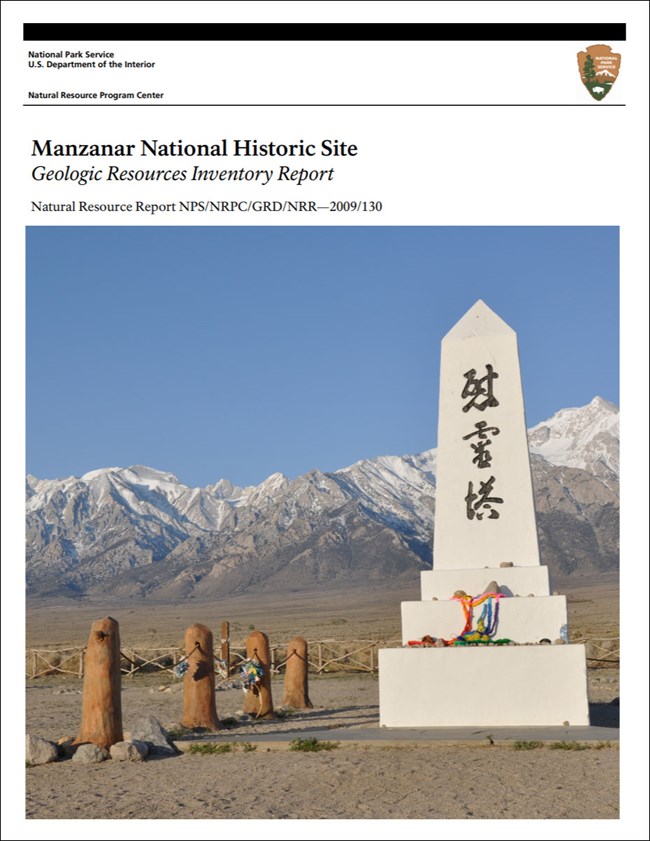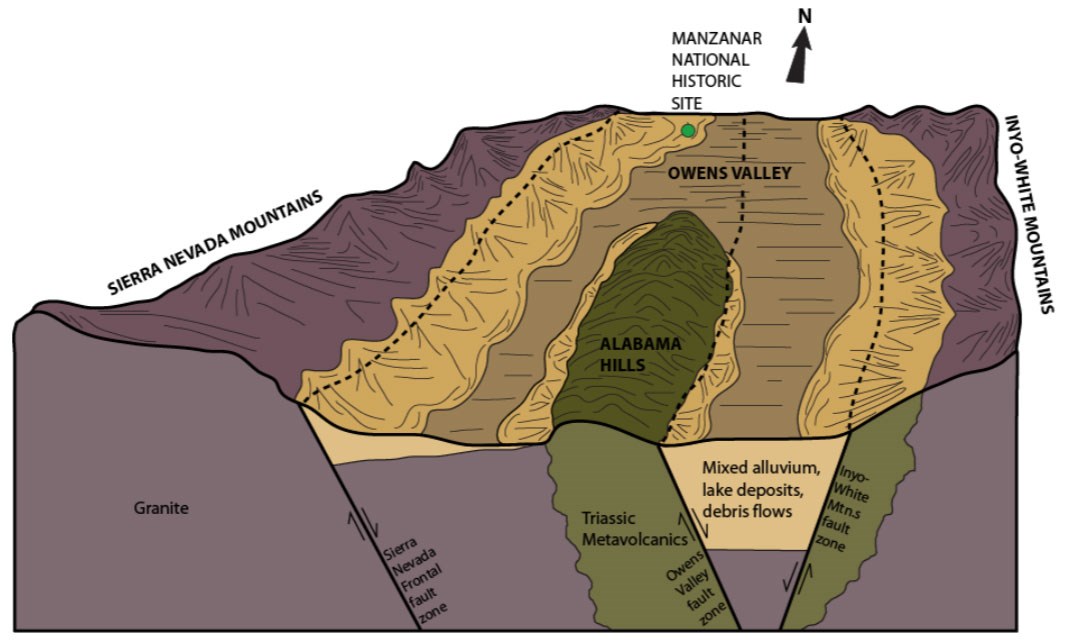Last updated: July 10, 2024
Article
NPS Geodiversity Atlas—Manzanar National Historic Site, California
Geodiversity refers to the full variety of natural geologic (rocks, minerals, sediments, fossils, landforms, and physical processes) and soil resources and processes that occur in the park. A product of the Geologic Resources Inventory, the NPS Geodiversity Atlas delivers information in support of education, Geoconservation, and integrated management of living (biotic) and non-living (abiotic) components of the ecosystem.

Introduction
Manzanar National Historic Site (MANZ) is situated against the backdrop of the Sierra Nevada Mountains in Inyo County, California. Located on the western side of Owens Valley, the historic site is positioned on an easterly sloping alluvial fan approximately 8 km (5 mi) east of the Sierra Nevada Front escarpment (Thornberry-Ehrlich 2009). MANZ was authorized as an NPS unit on March 3, 1992 and protects 329 hectares (814 acres) of natural, cultural, and historical resources, including those related to the relocation and internment of ~120,000 Japanese Americans during World War II (Anderson 2017). The historic site records a long history of human settlement, but also preserves a rich geologic history with active tectonic processes that continue to modify the landscape.
Geologic Setting
Most of the geologic history of the Manzanar National Historic Site area is not visible within MANZ itself, which is blanketed by Quaternary valley fill (Tweet et al. 2016). MANZ includes no bedrock outcrops, and the majority of its surficial geology can be lumped together as Holocene alluvium, with a small area of older Pleistocene alluvial deposits on the west edge of the site (Tweet et al. 2016). The last few million years in the Owens Valley has been a time of faulting, volcanism, glacial deposition, and large lakes. The major transform-normal faults of the valley are active to the present day, continuously uplifting the surrounding mountains relative to the valley floor due to regional Basin and Range-style crustal extension. Factors countering uplift include the continuous weathering and erosion of the highlands by glaciers, wind and water, and the deposition of immense amounts of sediment into Owens Valley (Thornberry-Ehrlich 2009).
Regional Geology
Manzanar National Historic Site is a part of the Cascade-Sierra Mountains Physiographic Province and shares its geologic history and some characteristic geologic formations with a region that extends well beyond park boundaries.
- Scoping summaries are records of scoping meetings where NPS staff and local geologists determined the park’s geologic mapping plan and what content should be included in the report.
- Digital geologic maps include files for viewing in GIS software, a guide to using the data, and a document with ancillary map information. Newer products also include data viewable in Google Earth and online map services.
- Reports use the maps to discuss the park’s setting and significance, notable geologic features and processes, geologic resource management issues, and geologic history.
- Posters are a static view of the GIS data in PDF format. Newer posters include aerial imagery or shaded relief and other park information. They are also included with the reports.
- Projects list basic information about the program and all products available for a park.
Source: NPS DataStore Saved Search 3011. To search for additional information, visit the NPS DataStore.
A NPS Soil Resources Inventory project has been completed for Manzanar National Historic Site and can be found on the NPS Data Store.
Source: NPS DataStore Saved Search 3058. To search for additional information, visit the NPS DataStore.

Graphic by Trista L. Thornberry-Ehrlich (Colorado State University), based on a graphic by Jessey and Wall (2006).
Related Links
Related Articles
Manzanar National Historic Site
National Park Service Geodiversity Atlas
The servicewide Geodiversity Atlas provides information on geoheritage and geodiversity resources and values within the National Park System. This information supports science-based geoconservation and interpretation in the NPS, as well as STEM education in schools, museums, and field camps. The NPS Geologic Resources Division and many parks work with National and International geoconservation communities to ensure that NPS abiotic resources are managed using the highest standards and best practices available.

